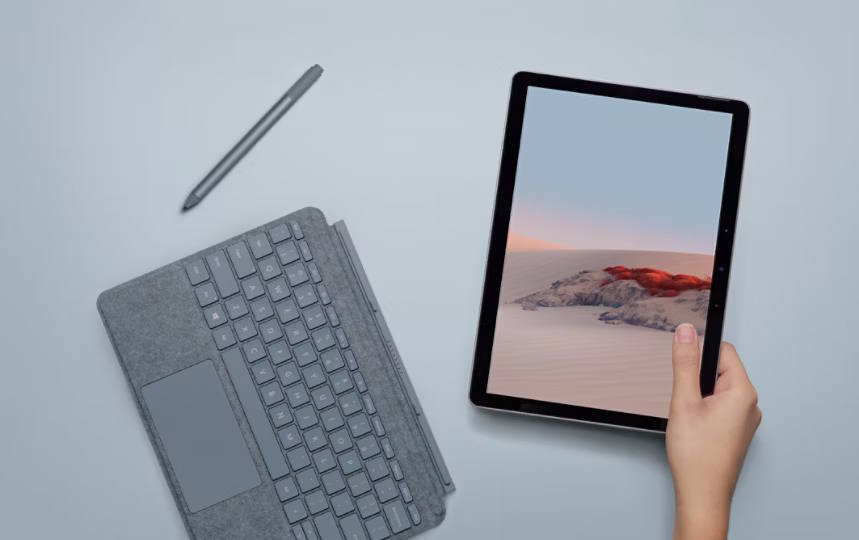Microsoft has steadily built its reputation in the hardware market, with the Surface lineup serving as a flagship representation of its vision for portable computing. Among its offerings, the Surface Go series has been aimed at users who need a compact, budget-friendly 2-in-1 device without sacrificing the premium feel associated with Surface products. The Surface Go 2, released in 2020, refined the formula introduced by the first-generation Surface Go, improving performance, display, and usability while keeping the device accessible to a broad audience.
A Quick Look at the First-Gen Surface Go
The original Microsoft Surface Go, launched in 2018, was Microsoft’s answer to users looking for an ultra-portable Windows device. It featured a 10-inch PixelSense display, an Intel Pentium Gold 4415Y processor, and up to 8GB of RAM. Designed primarily for students, casual users, and professionals who needed a secondary device, the Surface Go had a premium build but was slightly underpowered for heavier tasks.
What’s New in the Surface Go 2?
Microsoft Surface Go 2 introduced several key improvements over its predecessor:
Larger and Sharper Display – One of the most noticeable upgrades was the increase in screen size from 10 inches to 10.5 inches. This was achieved by reducing bezels, creating a more immersive experience. The resolution was also improved to 1920 x 1280 pixels, making text and images sharper.
Improved Performance – While the base model still used the Intel Pentium Gold 4425Y processor (a minor upgrade from the original), Microsoft introduced an optional Intel Core m3-8100Y variant, which offered significantly better performance for multitasking and productivity tasks.
Enhanced Battery Life – Microsoft optimized power efficiency, claiming up to 10 hours of battery life compared to the first model’s 9 hours. This allowed users to get through a full day of work or school without constantly reaching for the charger.
Better Front Camera and Dual Microphones – With the rise of video conferencing, Microsoft equipped the Surface Go 2 with a 5MP front-facing camera, making it ideal for Zoom or Teams calls. Dual Studio Mics improved voice clarity, a crucial feature for remote work and virtual learning.
LTE Connectivity Option – The Surface Go 2 provided an LTE Advanced option, giving professionals and students the ability to stay connected on the go without relying on Wi-Fi.
Smoother Windows 10 Experience – Running Windows 10 in S Mode by default (but upgradable to full Windows 10), the Surface Go 2 was positioned as a versatile device that could handle both lightweight applications and full-fledged Windows software.

Fast Comparison: Surface Go vs. Surface Go 2
| Feature | Surface Go (2018) | Surface Go 2 (2020) |
|---|---|---|
| Display | 10″ 1800×1200 | 10.5″ 1920×1280 |
| Processor | Intel Pentium Gold 4415Y | Intel Pentium Gold 4425Y / Intel Core m3-8100Y |
| RAM | 4GB / 8GB | 4GB / 8GB |
| Storage | 64GB eMMC / 128GB SSD | 64GB eMMC / 128GB SSD |
| Battery Life | Up to 9 hours | Up to 10 hours |
| Front Camera | 5MP | 5MP (improved quality) |
| Microphones | Standard | Dual Studio Mics |
| LTE Option | No | Yes |
Microsoft’s Hardware Strategy and the Role of Surface Go 2
The Surface Go 2 was a crucial part of Microsoft’s push to solidify its presence in the hardware market. By offering a well-built, relatively affordable Surface device, Microsoft attracted students, casual users, and even businesses looking for a lightweight, professional-looking tablet with Windows capabilities. The device also competed directly with Apple’s iPad, providing users who preferred a full Windows environment with a compact alternative.
While the Surface Go series was never meant to be a powerhouse, it showcased Microsoft’s ability to create versatile, well-designed devices in different price segments. With continued refinements in later models like the Surface Go 3 and Go 4, Microsoft has proven its commitment to providing users with a premium yet compact computing experience.
Final Thoughts
The Surface Go 2 was not a revolutionary device, but it was a meaningful evolution of the original Surface Go, addressing key pain points such as performance and display size. It reaffirmed Microsoft’s role in the growing market of 2-in-1 tablets, proving that Windows devices could be both portable and functional for everyday users. Whether for students, professionals on the move, or casual users, the Surface Go 2 stood as one of the best compact Surface devices Microsoft had released at the time.